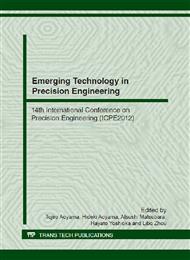p.40
p.46
p.50
p.54
p.58
p.64
p.70
p.76
p.81
Effect of Cutting Revolution Speed on Cutting Temperature in Helical Milling of CFRP Composite Laminates
Abstract:
CFRP (Carbon Fiber Reinforced Plastics) has higher specific strength, modulus of elasticity and so on. In the application for aviation industries, CFRP are remarkably used for many parts of airplane structures. It will be also widely applied for automobile parts in the future. CFRP is, however, well known as difficult-to-cut material which has very strong physical and mechanical characteristics. Drilling technique of CFRP which is one of the most important cutting operations is currently carried out in industrial factories. These manufactured parts have containing many precision holes for various purposes such as rivet holes. There are many typical problems in the precision drilling processes of CFRP plates which are burrs, chippings and delamination of composite materials, rapid wear of drilling tools and so on In our researches, it is found that drilled holes on CFRP plate by ball-nose end mill have good quality without any defections. By using the helical method with cemented-carbide ball end mill, high quality holes on the CFRP plates are obtained without burrs, chippings, and so on. However, cutting heat have negative effect on the strength of CFRP when it transcend heatresistant temperature of epoxy resin. In these researches, it is considered that the effect of the revolution speed to cutting heat on helical cutting of CFRP plates to improve the cutting processes. It is found that the cutting heat become lower by increasing revolution speed. Besides, because of shortening the cutting time, it is restrained the heat from transferring to the workpiece.
Info:
Periodical:
Pages:
58-63
Citation:
Online since:
November 2012
Authors:
Price:
Сopyright:
© 2012 Trans Tech Publications Ltd. All Rights Reserved
Share:
Citation:


